Reunion Island: An island to discover…from the inside!
Destination - Indian OceanWe’re catching up again with Olivier, a true multihull adventurer, who likes nothing more than a life on the ocean wave. Having left Rodrigues Island, he decided to stopover at Reunion Island rather than Mauritius. Why? He wanted to find some authenticity, and there was also a bit of nostalgia for our captain, who had stopped at St Denis in 1974 during his first deep sea voyage.
We decided not to stop in Mauritius as I already knew it well. It’s a wonderful island, but the tourism industry has been a little over-developed for our tastes. We worried that it might disappoint us after our wonderful stopover on Rodrigues. So, we headed for Reunion Island, 480 nautical miles from Port Mathurin. Calm conditions were forecast, so for the second 36 hours of the journey, the Volvo engines would help our progress… South of Mauritius, a school of bonito accompanied us for a few miles, flashes of silver dancing around the boat. But we couldn’t even catch one of them! We did catch a nice dolphinfish though (about 1.60m/5’), which fought tooth and nail on the port sugarscoop, freeing itself from the tip of the speargun harpoon which had hit it, and not just sending the gun into the depths, but also leaving me with a scar on my right foot… But what incredible energy!
A welcoming committee of dolphins!
Three days after leaving Rodrigues we were just north of Saint Denis. We were welcomed into the Baie de la Possession by the local dolphins performing their own ballet for us. There was also the blow of a humpback whale which was teaching its young one the rules of life before the long journey of initiation to the cold waters of the far south. She would also no doubt be keeping at bay the big sharks which have been terrorizing the island’s northwest coast for some years now. It was night-time when we entered the old port of Pointe les Galets. I could make out the silhouette of the Marion-Dufresne, the supply ship for the TAAF (Terres Australes et Antarctiques Françaises – the French Southern and Antarctic Lands). Memories came flooding back to me as I stood at the helm of our catamaran. It was the summer of 1974. I was a young officer cadet on board the cargo ship Ville de Hambourg, on my first deep sea trip. We had arrived here from Europe having sailed around the Cape of Good Hope. At the time, Reunion Island was much less developed than it is today. We unloaded all sorts of equipment from mainland France: trucks, cranes, refrigerators, construction materials, furniture, tools, spare parts, chemical products, cars, all sorts of cases, boxes and some of the first shipping containers. After staying there for a few days, and visiting the Gol sugar factory, taking up a reservation for officers to go to the ball at the St Denis Préfecture, not to mention downing a few beers “Chez Paula”, a long gone establishment (like its owner) which opened my eyes to adult life, we set sail again. We were heading for Mauritius, with over 4,000 tons of sugar cane in the holds which was destined for the Beghin Say factory in Nantes, France. I’ve been back to Reunion Island several times since that first visit. Boy has it changed! We headed into the former fishermen’s harbor which has since become a marina. It was at this point that the lady of the house was going to prepare dinner, but this was also the moment when the 15kg bottle of propane we bought in Bali decided to breathe its last. Well calculated Captain, but just a little too tight! Sometime later our friends arrived, and the crew left for the Etang Salé’s Californian house. There were no volunteers to stay on board… I came back alone the next morning on an incredibly high-performance bike, a Honda XR 650 R, to get all the entry formalities done and to welcome the Customs on board. They were surprised to find me alone on such a large catamaran. I told them about the gas bottle and how we had made a long trip. My grey beard and the wrinkles of a seasoned sailor seemed to reassure them and they accepted my excuse for the crew not being present…

France in the middle of the Indian Ocean
During our stay of practically a month on Bourbon Island (Reunion), we pretty much abandoned Jangada. She was moored securely in the former port of La Pointe des Galets, which had been partially converted into a comfortable marina. It is still an industrial kind of port, so is fairly charmless. The quayside used to be full of life, but now there is only the “Forban”, a bar restaurant in the outer harbor, sporting the famous logo “Le Dodo lé là” (the Dodo being the now extinct, flightless bird that was once endemic in the Mascarene Islands) with its free Wi-Fi for clients, that offers any kind of animation. Younger locals will tell you that this is one of the less frequentable areas of the island, but I don’t completely agree. It was much worse before. It was a rough port area, full of off-duty sailors, bars, fights, women of ill repute, and with the cargo booms, operated by winches running all through the sailors’ shifts. Today, there is practically no evidence of any of this. The port area has changed and has almost become clean. The commercial port has been moved into the deeper waters further east around La Possession. The cargo booms have disappeared, the winches don’t screech anymore and have been replaced by charmless container gantry cranes. Of course, the area is still inhabited by the descendants of all those people, but amongst those that I saw working on the decks and rigging of the deep-sea cargo ships that I worked on were some of the best dockers that I ever saw anywhere. They showed incredible dexterity keeping up an amazing speed, manipulating the noisy winch controls which maneuvered the high booms or heavy derricks. Their aim was to be the best dockers in the Indian Ocean, and nothing gave them more pleasure than to be told by the officer in charge of loading (which was often me) that they had been a bit quicker than Port-Louis (on neighboring Mauritius), or much quicker than in Tamatave (Toamasina today), the large port on the eastern coast of Madagascar, just across the water.

Static Comfort
The hectic lifestyle of our friends on Reunion Island soon drew us in. At their house in Etang Salé we rediscovered modernity, comfort and space. Free-running fresh water, fresh bread, cheese, good wine, a big fridge, a capsule coffee machine, computers, cars, toys. Everything that we had left behind when we departed from La Rochelle, and which hadn’t changed a bit. The children were in heaven. My other half was delighted to sleep in a large, immobile bed, with a bathroom just next door. It was a million miles from the several months of minimalist comfort that we had just spent on board our boat. While enjoying all the modernity, I didn’t forget that it was mainly because I had been deprived of it for several weeks… This shines a different light on the picture. For me, when considering lifestyle against my best memories, the static comfort that comes with modern life doesn’t hold a candle next to the simple life of a long voyage…
Having said that, Reunion Island is a great place for a boat. The island is a volcano which spills down into the sea. It’s on land and particularly in the interior where it gets interesting. It’s a magnificent island which is well worth discovering. In a fairly restricted zone, you can do practically any activity, apart from those that involve snow. The island’s historical ethnic melting pot, which continues to this day, has had a positive effect. Réunionnais society has its problems of course, like everywhere else, but generally, it’s an island with a good quality of life.

Charming Saint-Pierre
The town of Saint-Pierre, on the island’s south west coast is a charming place. Apart perhaps from the traffic! The Saturday market is the high point of the weekends. To our greedy eyes it offered an amazing selection of fresh fruit and vegetables, all sorts of juices, good fresh bread, smoked chicken, samosas, coconut ice cream, vanilla, honey, spices and plenty more. Adélie was very taken with the artisanal stalls, mostly supplied by the many workshops in Madagascar a few hundred miles away. She treated herself to a lovely little colored baobab with the money she had earned in New Zealand. The seafront is quite lively, despite it only being a narrow strip between the first hills and the coral reef, which sometimes makes for an interesting entrance into or exit from the little port. The swell which comes from the south west really hits hard, creating a backwash which put us off taking our catamaran there, as our beam can be an issue in some smaller marinas like this one. The only spot that we could have taken was on the town side, against the solid quayside wall, and was too exposed. It was a shame, as there are several advantages of stopping over here rather than at Pointe des Galets, never mind the prices charged by the Saint-Pierre municipality which are much lower than those of Saint Denis which manages the Pointe des Galets marina. The surroundings are much nicer, the marina is in the town center and the shops, bars and restaurants are right there…
Man is made up of contradictions. I’m no exception. I have to confess that I, despite holding the consumer society in disdain, along with the unbelievable waste that goes with it and the vacuousness of this so-called idea of growth reflected in the all the unnecessary riches around us, can quite happily, after a few weeks at sea in the wilds of the Indian Ocean, spend a couple of hours trawling the aisles of a supermarket (I don’t buy anything, but just look!). I am always blown away by modern man’s capacity, whether good or bad, to imagine and create with ever more efficient technology new products and sub-products which just serve to create more unreasonable demand. In my opinion, what humanity needs today, and it hasn’t changed since antiquity, is a bit of philosophy in the sense defined by the ancient Greek term. In other words, basing our actions upon wisdom…

The Gol sugar refinery…
Thirty-seven years after my first visit, I decided to take my little crew to the Gol sugar refinery, which is situated close to the town of Saint-Louis on the west coast. The sugar cane industry on Reunion Island employs 12,000 people in the agriculture, industry, transport, energy and research sectors. 3,500 of those are farmers who cultivate around 25,000 hectares (nearly 100 square miles) from which they produce around 1,900,000 tons of sugar cane. There are two factories on the island, Gol and another one at Bois-Rouge, and they produce 200,000 tons of different sugars, (because there are different varieties), making the island Europe’s number one producer as it is a French overseas territory. Sugar represents 85% of the island’s exports in terms of volume!
On Reunion Island, the sugar campaign begins in mid-July and ends in December. One hectare (2½ acres) of cane produces around 8 tons of sugar cane. A ton of sugar cane produces around 110kg (240 lbs) of sugar. They may just be numbers, but they do help to get a bit of perspective on the industry. After all, if we don’t learn anything when we travel, we may as well stay at home.
The cane which is harvested by the farmers is transported by tractors and trailers to reception centers which are located throughout the plantation zones. This is when the great big “cachalots” or big green wagons, filled to the brim with canes start to take to the island’s winding roads. They look after the transportation between the reception centers and the factories. The cane is then unloaded onto the production line, where it is defibered, before being passed through five different grinding mills which extract the juice. Just before the last grinder, hot water is injected, which washes the cane and allows for maximal juice extraction and therefore more sugar. At the end of this grinding cycle, they are left with two products: on the one hand there is the raw cane juice (“vesou”) and on the other, the “bagasse”. Bagasse is the fibrous residue of the cane once the juice has been extracted. It is then chopped up and used in the furnaces of the local power plant where it is used to produce electricity. The juice itself is then degassed, purified and decanted. During the decantation, residues settle at the bottom of the basins. These residues are recycled as fertilizer for the plantations. The next phase is the evaporation. The decanted and filtered clear juice is heated by steam. The water evaporates and the juice becomes a syrup. Then comes the first cooking stage. The mixed syrup starts to become more concentrated because of the cooking, and a sugar powder is added to kick start the crystallization process. Stirring the cooked paste encourages the crystals to grow in size. Centrifuges are used to separate the crystals from this first liquor. Sugar A has now been separated. This is the top quality. Two further cookings of the residual liquor will produce sugars B and C, with the sugar quality diminishing each time. The Gol factory produces sugar but no rum.
There are however, several distilleries on the island which produce either “traditional rum” or “agricultural rum”. The agricultural rum is definitely better as it is made from the raw cane, while the traditional is actually just an industrial product made from the molasses, which are just a residual product. Agricultural rum production is fairly recent on Reunion. The quality of the local terroir and the local cane do not match those which make the magnificent Caribbean rums of Guadeloupe and Martinique. Well you can’t have it all I suppose…

The sharks attack from the west
The coast of Reunion Island is not ideal for sailing. However, it’s a great place for windsurfing, kitesurfing and diving. Over the last ten years or so, things have changed, and there is danger in the water… For reasons that are not fully understood, there are more and more shark attacks around Reunion Island, and researchers are trying to understand why. A closer look at the statistics, shows that Reunion holds the world record for the dangerousness (or mortality!) of its shark attacks. 58% of attacks have fatal consequences! There are two particularly dangerous species of shark that swim around the Indian Ocean’s blue waters, in the shadow of the volcano: the bull shark and the tiger shark, and they are as bad as each other. They are both big species which are very good attack hunters. 80% of documented attacks featured one or the other of these sharks. Bull and tiger sharks are opportunists. They will eat dead as well as live prey: marine turtles, rays, seals, fish and from time to time… a human specimen! Shark attacks have been officially documented since 1980. Before that, only five cases had been officially reported. The average until quite recently, was then one or two attacks per year. Yet since 2011, there has been a rapid rise in attacks around the island. So, what is happening to the sharks in the region? It’s interesting to look at the activities of the victims. Around 40% of them are surfers, windsurfers or kitesurfers. 30% are swimmers and snorkelers, 22% are fishermen and 10% are scuba divers. Another interesting fact is that the average distance from shore of the attacks is only 35 meters (100 feet). The sharks aren’t far away!
Reunion Island has the second highest number of attacks per inhabitant in the world after Hawaii and equal with Florida. Australia and South Africa are a long way behind.
Thankfully, the island can offer plenty of other, non-aquatic activities. For example, Marin discovered “long board”. This is a long board on wheels, upon which those who aren’t afraid of scraping their elbows, can take on the slope of a long, winding, abandoned but surfaced road to the west of the island. There is no shortage of sporting activities on Reunion Island. The backdrop is ideal and magnificent.

A strange island ballet
At the end of October, we were treated to a magnificent spectacle. To get a closer look, we jumped onto a friend’s motorboat, negotiated our way through the narrow, twisty channel of the small lagoon, and headed for the whales’ playground a few minutes further away, not far from the shore. These are “jubarte” or humpback whales. The adults are around 15 meters (50’) long with some as long as 18m (60’), and weigh between 25 and 40 tons. When it is born, the baby whale is 4 to 5 meters (12-16’) long, and weighs around 1.3 tons. Their heads have numerous protuberances which are characteristic of the species. The females give birth to one baby every 2 or 3 years after an 11 to 12-month gestation period. The baby feeds off its mother’s very rich milk for 5 months and puts on around 60kg (130 lbs) … per day! In the space of a few months it needs to have put on enough weight to take on its long migratory initiation in the cold waters of the Southern Ocean. Hunted mercilessly since the 18th century, the species saw its numbers decline from over 150,000 individuals to less than 10,000 today… Humpback whales do not have teeth but baleens and feed on schools of small fish and krill in the cold waters. They can stay underwater for 30 minutes and go down to a depth of 200 meters (650’). They spend their summers in the cold, polar waters, heading north to the warmer tropical waters in winter to reproduce and give birth. It is always a magical, majestic but somehow mysterious experience to see these great animals moving graciously on the surface before throwing themselves into incredible jumps which inevitably end up with a huge geyser of spray…
On October 24th, the crew rejoined the poor, abandoned Jangada. We spent a week getting the boat ready, the kids did some intensive school work and we waited for a weather window before setting sail for South Africa. We had no regrets and had really made the most of this island’s fabulous natural attributes, including discovering the mountainous cirques of Cilaos, Mafate and Salazie. Reunion Island was a very happy, comfortable and welcome interlude in our journey!
Destinations offered by
View all the destinations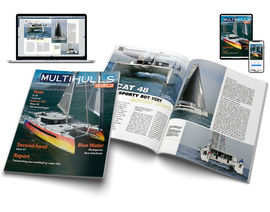
Subscribe and get 8 issues a yearfor just $39.90
subscribeClassified ads
View classified adsSAMANA 59 VERSION PROPRIETAIRE DE 2022
- Location :
- Cogolin, France
- Year :
- 2022
Privilege 615 (2008 - Refit 2020-2022 ) - v. 4 cabins
- Location :
- Canet en Roussillon, France
- Year :
- 2008
 Discover the 2025 winners!
Discover the 2025 winners! 
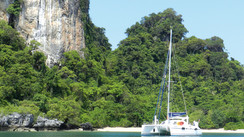
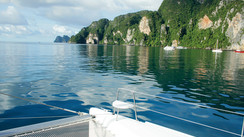
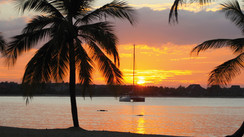
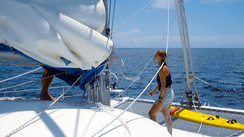
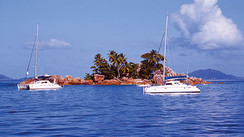
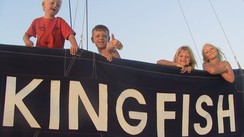







What readers think
Post a comment
No comments to show.